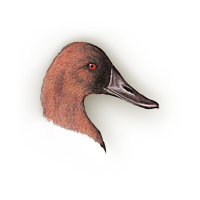|
Aythya
valisineria Wilson Field
Guide IDs: BREEDING:
Open, freshwater
marsh, pond, lake, river, bay, bordered by emergent
veg. 1 brood. DISPLAYS:
See:
Duck
Displays NEST:
Well-concealed,
rimmed, basket-shaped on bulky emergent veg over
water up to knee-deep. Lined with finer materials
and down. Occ uses muskrat house; rarely on dry
ground. EGGS:
Grayish- or
greenish-olive. 2.4" (62 mm). DIET:
Aquatic vegetation,
aquatic invertebrates, esp. small clams. CONSERVATION:
Winters s to s
Mexico. Blue List 1975-81, Special Concern 1982,
1986. Draining and cultivation of prairie potholes
and freshwater marshes have reduced breeding
grounds. NOTES:
Females highly
"philopatric" (often return to natal area to
breed); males virtually never do so. Mated pair
never rejoin as pair in subsequent years. Male
deserts when clutch complete. Nests often
parasitized by Redhead. Females retain fat store
during laying but lose nearly 70% during
incubation. ESSAYS: Blue
List;
Metallic
Poisons;
Parasitized
Ducks;
Dabblers
vs. Divers;
American
Coots;
Commensal
Feeding;
Brood
Parasitism REFERENCES:
Anderson, 1985;
Bellrose, 1976; Gooders and Boyer, 1986; Noyes and
Jarvis, 1985. |
